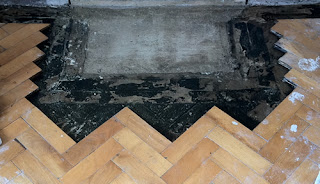 Hello and welcome to another Woodfloor-Renovations Blog Post.
Hello and welcome to another Woodfloor-Renovations Blog Post.
Firstly I'd like to apologise for the lack of output from myself the last couple of weeks.....we've been pretty busy pushing and pulling the sanding machine and time has been at a premium.
Today I'll expand on a subject that many people try and do, but few do really well, the question [via email] is: "I'm sanding my wood floor myself, what advice would you give me ??"
The wood floor in the picture was sent in by our man asking the question, the species is also unknown to him and is apparently original to the property and looking a bit on the rough side I must say - I would hazard a guess at either Maple or Beech as the species [actual picture below]
This wood floor could be one of half a dozen or more different species, the orange 'glow' will be thanks to a seal called Bourneseal, which was commonly used back in the day - but any wooden floor it touched would end up this orange colour - avoid at all costs.
The worst mistake the average DIY floor sander makes is hiring poor quality sanding machinery, and by that I mean most of the hire shop fleet of HT7 and HT8 machines. These machines have precious little in the way of dust capture and are an absolute country mile away from the standard of Professional floor sanding kit.
If you are serious about doing the best job you can on your wood floors, then hire the better quality machinery which is available at many outlets nationwide [UK] it of course costs a bit more than the standard hire shop fodder but if done properly the results will speak for them selves.
The minimum machinery level I would suggest you will need are as follows, [IMHO] if your budget can stretch to the professional kit, then try and hire either a Bona 10" Sanding Machine as the main sander, or the Lagler Hummel.
These two beasts are arguably the best two sanding machines in the business, I personally have used both of them on several large scale projects, and as i run a nearly new Bona 10" sander on a day to day basis I would have to say its the better machine, but its close, the Hummel is a superb bit of kit also and can tackle the hardest of jobs with aplomb.
You will also need a good quality edging machine, both Bona and Lagler have these machines in their respective armoury's, both will do the job really well, if you have multiple rooms I would suggest hiring the 7" version as it is just more powerful and a little bit quicker than its 6" sibling.
Next on the list is the Buffing/Finishing machine, this is used to put the final smoothness to the floor, it is usually the last 2 or 3 processes that put the most quality into the job. Bona have an excellent buffing machine, cunningly called the 'Bona Buffer' its pretty easy to use and does a great job.
Lagler have arguably the best finishing machine in the business, the Trio - this is a superb machine and can put a world class finish on most floors, although Parquet floors are its forte its also tremendous on just about every Hardwood floor out there. The Trio is an expensive piece of kit and is consequently not cheap to hire, but you will get a superbly smooth finish to your wood floor if used correctly.
Many companies here in the UK that hire the professional standard equipment, will hire out the equipment individually or in a package form, where you can hire the relevant equipment that best suits your particular needs, if you tell these companies what type of floor you have, the size of the area and your time-frame and budget, they will give you the best advise they can I'm sure.
Anyone contemplating sanding a floor themselves must be prepared to do their homework...and then some...Sanding a wood floor properly and getting a professional finish is not easy, and for someone with no experience or know-how the chances of getting a high quality finish on your floors are slim...even with professional kit...but, and its a big but, if you research the subject in depth, take your time and hire the best machinery you can afford you will give yourself a fighting chance.
Hope that helps - thanks for reading.















